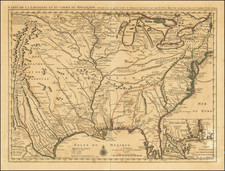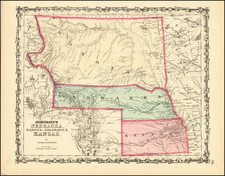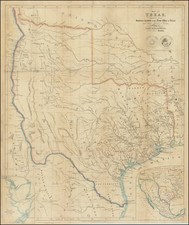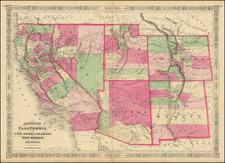First Map To Name New Orleans -- "The Mother and Main Source of All the Later Maps" of the Mississippi River and Interior Parts of the United States and The First Map to Name Texas
Second state of De L'Isle's seminal map, one of the most important and influential maps of the 18th Century.
This second state of De L'Isle's map is the first map to name New Orleans. La Nouvelle-Orleans was founded by Jean Baptiste Le Moyne de Bienville in the Spring of 1718.
De L'Isle 's map is "the first large-scale map accurately showing the lower Mississippi River and surrounding areas” and the first printed map to properly locate and name ‘Texas.’ “The most important notation to Texas history [on the map]... was that appearing along the Trinity: ‘Mission de los Tiejas, etablie in 1716.’ . . . This phrase marked the first appearance of a form of the name Texas on a printed map, and thus Delisle has received proper credit for establishing Texas as a geographic place name.”
One of the most widely copied and influential maps ever produced. The map contains the first indications of the explorations of De Soto, Cavelier, Tonty, Moscoso and Denis. It included the best depiction of the Mississippi River to date, for the first time presenting a roughly accurate delineation of its entire length, as well as a semblance of accuracy about many of its tributaries. It was also the first map to include the name Texas with the legend "Mission de los Teijas," indicating a Mission established in 1716.
De L'Isle's maps had an immense impact on the history of cartography, and none more so than this map. It was based on years of research, using all the latest reports of travels, explorations and surveys in the region. Delisle was particularly well placed with respect to gathering information on North America, using De L'Isle's connections in the French Court to access the best available published and unpublished accounts and maps of the New World.
De L'Isle's map was the first accurate delineation of the Mississippi Valley system and "the first printed map to show Texas."
As noted by Cohen:
A significant map in Western American history and a work by one of the greatest mapmakers of all time. The map revealed for the first time the importance of the Missouri River and gave the most accurate delineation of the Mississippi Valley up to that time… [Delisle's] passion for pure scientific accuracy is reflected on his maps. If geographic information had not been directly observed by a reliable source, he refused to acknowledge it. Many longstanding myths and errors that had been passed from mapmaker to mapmaker for generations were suddenly absent on Delisle's maps.
A seminal map for Americana collectors.
Guillaume De L'Isle (1675-1726) is probably the greatest figure in French cartography. Having learned geography from his father Claude, by the age of eight or nine he could draw maps to demonstrate ancient history. He studied mathematics and astronomy under Cassini, from whom he received a superb grounding in scientific cartography—the hallmark of his work. His first atlas was published in ca. 1700. In 1702 he was elected a member of the Academie Royale des Sciences and in 1718 he became Premier Geographe du Roi.
De L'Isle's work was important as marking a transition from the maps of the Dutch school, which were highly decorative and artistically-orientated, to a more scientific approach. He reduced the importance given to the decorative elements in maps, and emphasized the scientific base on which they were constructed. His maps of the newly explored parts of the world reflect the most up-to-date information available and did not contain fanciful detail in the absence of solid information. It can be fairly said that he was truly the father of the modern school of cartography at the commercial level.
De L’Isle also played a prominent part in the recalculation of latitude and longitude, based on the most recent celestial observations. His major contribution was in collating and incorporating this latitudinal and longitudinal information in his maps, setting a new standard of accuracy, quickly followed by many of his contemporaries. Guillaume De L’Isle’s work was widely copied by other mapmakers of the period, including Chatelain, Covens & Mortier, and Albrizzi.











![[Shows Republic of Texas] United States and Texas](https://storage.googleapis.com/raremaps/img/small/101139.jpg)


![[Montana, Wyoming, Colorado, Dakotas, etc] Reconnaissances in the Dacota Country By G.K. Warren](https://storage.googleapis.com/raremaps/img/small/82655.jpg)
